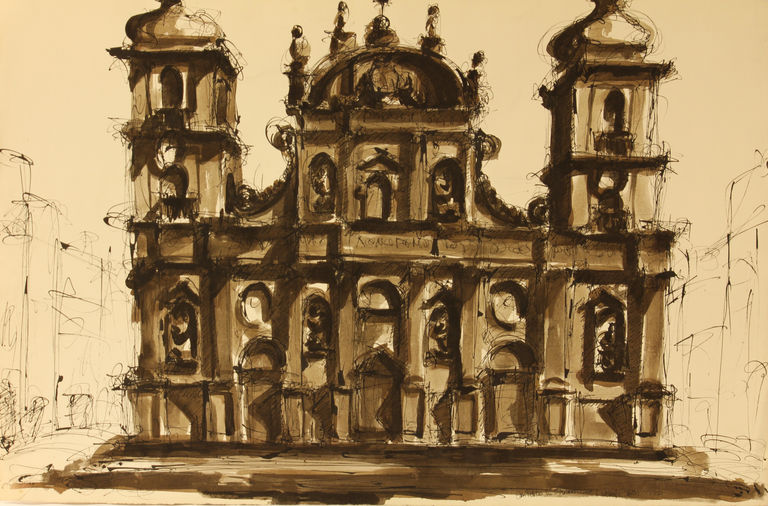Michael Graves and the Art of Drawing
Drawing by hand stimulates the imagination and allows us to speculate about ideas, a good sign that we’re truly alive.
—Michael Graves
The Art Museum has recently acquired an extraordinary group of drawings by the renowned American architect and designer Michael Graves (1934–2015). The nearly five thousand works, which come to the Museum from Graves’s estate, span the entire range of his subject matter and design concerns and will form an immensely important resource for researchers and designers and for display in the Museum galleries. Graves founded his eponymous practice in Princeton in 1964 and taught architecture at Princeton University for thirty-nine years, retiring as the Robert Schirmer Professor of Architecture Emeritus in 2001. He is known internationally for his innovative and transformative postmodern designs for a vast array of buildings, interiors, master plans, and consumer products on behalf of public and private clients around the world.
 All of the drawings that will come to Princeton—which were variously executed in pen and ink, charcoal, graphite, colored pencil, watercolor, and pastel—are in Graves’s own hand. There are exuberant drawings of historic monuments from his 1960s fellowship at the American Academy in Rome, pencil and ink referential drawings in sketchbooks, quick iterative design studies on yellow tracing paper, and meticulously colored building elevations. “They represent every phase of design, from the initial conception through the thoughtful design of the character of a building or product,” notes Karen Nichols, a principal at Michael Graves Architecture & Design. “As his colleagues and collaborators in our architecture and design firm, we are thrilled that the Art Museum is acquiring this important collection. Michael often said that his practice was one of his best designs. However, we think that his process of discovery and creation through drawing was his great gift to the thousands of students he taught as well as to the profession.”
All of the drawings that will come to Princeton—which were variously executed in pen and ink, charcoal, graphite, colored pencil, watercolor, and pastel—are in Graves’s own hand. There are exuberant drawings of historic monuments from his 1960s fellowship at the American Academy in Rome, pencil and ink referential drawings in sketchbooks, quick iterative design studies on yellow tracing paper, and meticulously colored building elevations. “They represent every phase of design, from the initial conception through the thoughtful design of the character of a building or product,” notes Karen Nichols, a principal at Michael Graves Architecture & Design. “As his colleagues and collaborators in our architecture and design firm, we are thrilled that the Art Museum is acquiring this important collection. Michael often said that his practice was one of his best designs. However, we think that his process of discovery and creation through drawing was his great gift to the thousands of students he taught as well as to the profession.”
Best known for his large-scale architectural projects—such as the Humana building in Louisville, the Denver Public Library, and the Portland Building in Portland, Oregon—and for the design of household objects high and low for firms such as Alessi and Target, Graves also left his creative mark on Princeton, including at the Paul Robeson Center for the Arts on the corner of Witherspoon Street, completed in 2008, and at his former residence, The Warehouse, described by Museum Director James Steward as “Michael’s Monticello, the ongoing focus and forum for his innovation.” Like many twentieth-century architects who designed furniture and household objects as well as homes and other buildings, Graves believed that good design should find its way into everyday life and be available for consumers at all price levels.
Together, the drawings in the collection form the essential visual archive of Graves’s work, revealing both his classical training and his commitment to draftsmanship—something Graves advocated for strongly in his teaching. According to Patrick Burke, one of Graves’s students as well as a principal at his firm, “Drawing was fundamental to Michael’s creative process. He always drew with a purpose, whether to remember something he saw, capture an idea, or carefully develop a design.” Indeed, in a 2012 opinion piece for the New York Times titled “Architecture and the Lost Art of Drawing,” Graves wrote, “Architecture cannot divorce itself from drawing, no matter how impressive the technology gets. Drawings are not just end products: they are part of the thought process of architectural design. Drawings express the interaction of our minds, eyes, and hands.”
